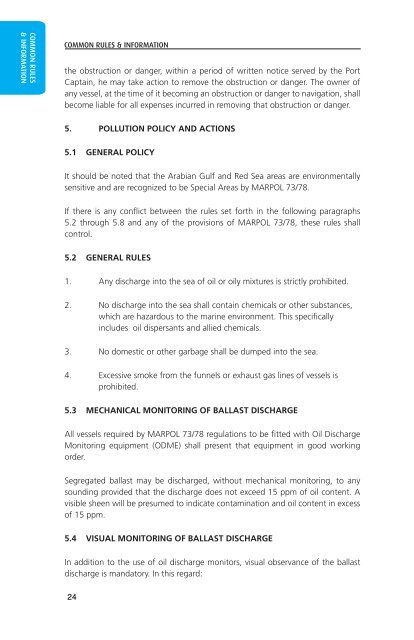Common Rules - Saudi Aramco
Common Rules - Saudi Aramco
Common Rules - Saudi Aramco
You also want an ePaper? Increase the reach of your titles
YUMPU automatically turns print PDFs into web optimized ePapers that Google loves.
COMMON RULES<br />
& INFORMATION<br />
COMMON RULES & INFORMATION<br />
the obstruction or danger, within a period of written notice served by the Port<br />
Captain, he may take action to remove the obstruction or danger. The owner of<br />
any vessel, at the time of it becoming an obstruction or danger to navigation, shall<br />
become liable for all expenses incurred in removing that obstruction or danger.<br />
5. POLLUTION POLICY AND ACTIONS<br />
5.1 GENERAL POLICY<br />
It should be noted that the Arabian Gulf and Red Sea areas are environmentally<br />
sensitive and are recognized to be Special Areas by MARPOL 73/78.<br />
<br />
5.2 through 5.8 and any of the provisions of MARPOL 73/78, these rules shall<br />
control.<br />
5.2 GENERAL RULES<br />
1. Any discharge into the sea of oil or oily mixtures is strictly prohibited.<br />
2. No discharge into the sea shall contain chemicals or other substances,<br />
which are hazardous to the marine environment. This specifically<br />
includes oil dispersants and allied chemicals.<br />
3. No domestic or other garbage shall be dumped into the sea.<br />
4. Excessive smoke from the funnels or exhaust gas lines of vessels is<br />
prohibited.<br />
5.3 MECHANICAL MONITORING OF BALLAST DISCHARGE<br />
All vessels required by MARPOL 73/78 regulations to be fitted with Oil Discharge<br />
Monitoring equipment (ODME) shall present that equipment in good working<br />
order.<br />
Segregated ballast may be discharged, without mechanical monitoring, to any<br />
sounding provided that the discharge does not exceed 15 ppm of oil content. A<br />
visible sheen will be presumed to indicate contamination and oil content in excess<br />
of 15 ppm.<br />
5.4 VISUAL MONITORING OF BALLAST DISCHARGE<br />
In addition to the use of oil discharge monitors, visual observance of the ballast<br />
discharge is mandatory. In this regard:<br />
24

















